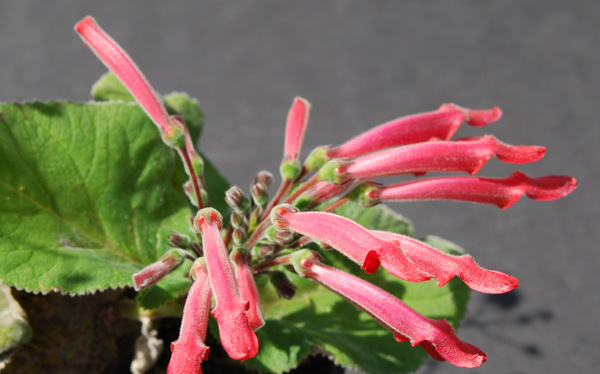
| Species list |
Hybrids list |
Tubers list |
Topics list |
Site index |
What's new |
Home page |
Sinningia iarae is a nice species with dusky-red galeate flowers. Mine have the galea bent upward, but this does not appear to be a universal character of this species. The conical tuber is also attractive.

Photo by Mike Kartuz, of his own plant.
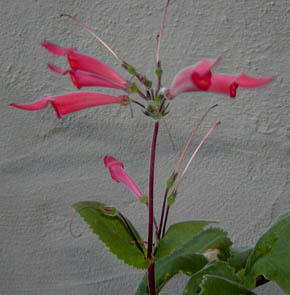
Photo of my plant |
Sinningia iarae is an attractive species. The large heart-shaped leaves are normal fuzzy cardinalis green, but the stems, petioles, pedicels, and midrib of the leafback are dark red. Sinningia iarae is one of the Galea Group, with the upper two lobes of the corolla fused into a hood which overhangs the anthers and stigma. Flower color is often a distinctive dusky red, quite different from the brilliant red of S. cooperi, for instance. |
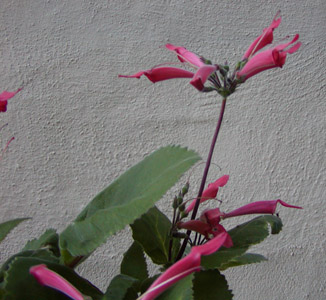
|
Recurved galeaIn my plants, the galea is slightly recurved (bent backwards), which is also unusual. The other species with a slightly recurved galea is its close relative S. glazioviana. The inflorescence is worth noting also. There are flowers from the axils of the uppermost vegetative leaves, and then a stalk which is a continuation of the vegetative axis, culminating in more flowers in the axils of very small bracts. There are no peduncles. |
TuberThe tuber of Sinningia iarae has a distinctive high-dome top. This can sometimes be very attractive. Bill Price exhibited a handsome S. iarae with a very fine tuber at the 2005 Gesneriad Society convention in Portland, Oregon. See a picture here. |
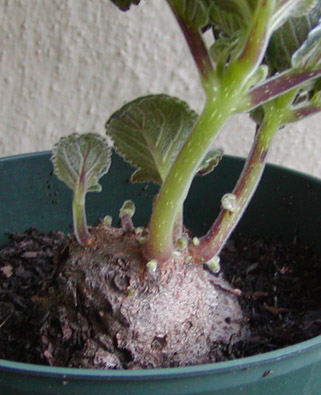
|
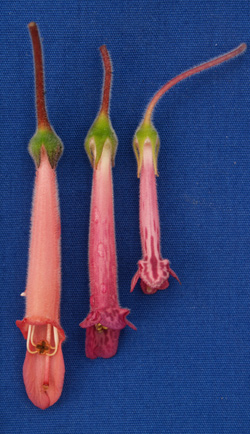
|
HybridizationI have crossed S. iarae with S. reitzii to get a nice but unnamed plant, and also with another hybrid; the latter plants have not yet bloomed. This picture, by Jon Lindstrom, shows the flowers of S. iarae on the left, S. piresiana on the right, and the hybrid between them in the middle. Jon likes to characterize the hybrid flower as having a small galea, and he has a point: this flower clearly gets some of iarae's overhanging upper lip. I prefer to reserve the term galea for flowers in which the overhang is a substantial fraction of the length of the flower and in which the stigma and anthers protrude from the tube but not beyond the upper lip of the corolla. Others have used S. iarae in hybridizing; see the crossing table for details. |
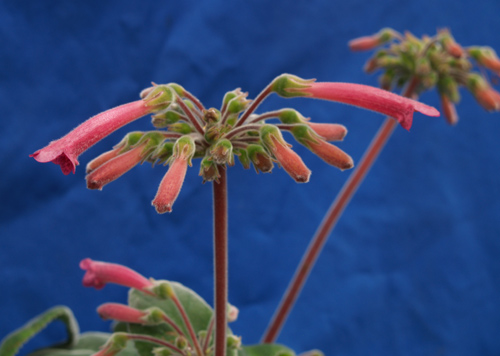
Sinningia iarae x piresiana: photo by Jon Lindstrom of his own plant. |
|
| Plant Description |
|
| Growth | Determinate |
| Habit | 2-3 leaf pairs |
| Inflorescence | terminal peduncle |
| Leaves | It has some. |
| Dormancy | Stems fully deciduous. Dormancy appears to be obligate. |
Flowering |
|
| Season | Summer |
| Inflorescence | Terminal peduncle |
| Flower | Dusky red, tubular, with galea |
Horticultural aspects |
|
| Hardiness | Has survived 30 F (-1 C) in my yard without leaf damage, but was killed by 25 F (-3 C) |
| Recommended? | Yes, with reservations. I like the conical tuber and the dusky red flowers. On the other hand, it has not been easy for me to keep alive. |
Hybridization |
|
| Hybrids with this species | See listing. |
Botany |
|
| Taxonomic group | The galea group of the Dircaea clade. |
| Nectaries | Two, separate, dorsal |
PublicationChautems, 1995, in Gesneriana 1(1). The species is native to São Paolo state, where it is known as orelha de onça ("jaguar's ear"). Sinningia iarae is named for Iara Peixoto of Brazil. Iara is a popular female name in Brazil. It is derived from the Tupí myth about a water nymph of that name. See the Wikipedia article for more information. Another fact I learned from looking around in Wikipedia is that the English word jaguar is from the Tupí language, which was never spoken in what's now the USA, while the corresponding Portuguese word onça is not from Tupi, even though Tupí was spoken over wide areas of Brazil before the arrival of Europeans. The word onça comes from Latin lyncea ("lynx") by a complicated etymology, for which Wikipedia once again has an explanation. I have gotten way off topic. I will stop now. |